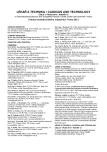-
Články
- Časopisy
- Kurzy
- Témy
- Kongresy
- Videa
- Podcasty
ECMO ambulance and advanced emergency medical system
In our article we propose a way to improve outcomes for out-of-hospital patients suffering from cardiac and circulatory arrest. The quality in providing emergency medical care for these patients varies from state to state, from city to the city. There are cities where the emergency medical system (EMS) personnel declares the death in the patients with circulatory arrest without knowing the real reason of death, after a certain time of cardiac massage, after unsuccessful defibrillations, out of the hospital, on the street. On the other hand, there are cities where the patient is resuscitated on the street/at home, during the time of transport to the hospital, at the hospital and the death is declared only after all, albeit unsuccessful attempts to save patients (at the hospital). From the above it is evident, that we need an interdisciplinary clinical pathway, which helps everyone who is participating in the life saving of these patients. We want to meet our goals of the project using high-tech medical knowledge. VA ECMO implemented by experienced specialists outside the hospital for ensuring oxygenation and blood circulation with the help of a device situated outside the patient regardless of the activity of his heart and lungs, represents the most up-to-date technology.
Keywords:
Extracorporeal membrane oxygenation, Emergency medical system, Clinical Guidelines
Autoři: David Macků 1,2; Petr Huňka 1; Filip Ježek 1
Působiště autorů: Department of Cybernetics, Faculty of Electrical Engineering, Czech Technical University, Prague, Czech Republic 1; Department of Biomedical Engineering, Na Homolce Hospital, Prague, Czech Republic 2
Vyšlo v časopise: Lékař a technika - Clinician and Technology No. 3, 2012, 42, 14-16
Souhrn
In our article we propose a way to improve outcomes for out-of-hospital patients suffering from cardiac and circulatory arrest. The quality in providing emergency medical care for these patients varies from state to state, from city to the city. There are cities where the emergency medical system (EMS) personnel declares the death in the patients with circulatory arrest without knowing the real reason of death, after a certain time of cardiac massage, after unsuccessful defibrillations, out of the hospital, on the street. On the other hand, there are cities where the patient is resuscitated on the street/at home, during the time of transport to the hospital, at the hospital and the death is declared only after all, albeit unsuccessful attempts to save patients (at the hospital). From the above it is evident, that we need an interdisciplinary clinical pathway, which helps everyone who is participating in the life saving of these patients. We want to meet our goals of the project using high-tech medical knowledge. VA ECMO implemented by experienced specialists outside the hospital for ensuring oxygenation and blood circulation with the help of a device situated outside the patient regardless of the activity of his heart and lungs, represents the most up-to-date technology.
Keywords:
Extracorporeal membrane oxygenation, Emergency medical system, Clinical Guidelines
Zdroje
[1] European Resuscitation Council Guidelines for Resuscitation 2010. August 2011. (www.cprguidelines.eu/2010/)
[2] Extracorporeal Life Support Organization (ELSO) - General Guidelines for all Extracorporeal Life Support (ECLS) cases. August 2011 (www.elso.med.umich.edu/WordForms/ELSO%20Guidelines%20General%20All%20ECLS%20Version1.1.pdf)
[3] Zimmermann et al. From Baghdad to Germany: Use of New Pumpless Extracorporeal Lung Assist System in Two Severely Injured US Soldiers. ASAIO Journal 2007;53:e4-e6.
Štítky
Biomedicína
Článek Editorial
Článok vyšiel v časopiseLékař a technika

2012 Číslo 3-
Všetky články tohto čísla
- ECMO ambulance and advanced emergency medical system
- Measurement of thermal symmetry of the human spine by the use of medical thermography
- Editorial
- Determination of Human Gait Phase by Zero-moment Point
- Stanovení pohybové aktivity na základě výsledků zátěžového vyšetření
- Vliv fotodynamické terapie na cytomechaniku nádorové buněčné linie HeLa
- Inovace praktických úloh ve výuce lékařské biofyziky Lékařské fakulty univerzity palackého
- Leksell gamma knife past, present and future
- Lékař a technika
- Archív čísel
- Aktuálne číslo
- Informácie o časopise
Najčítanejšie v tomto čísle- Leksell gamma knife past, present and future
- Stanovení pohybové aktivity na základě výsledků zátěžového vyšetření
- Vliv fotodynamické terapie na cytomechaniku nádorové buněčné linie HeLa
- Inovace praktických úloh ve výuce lékařské biofyziky Lékařské fakulty univerzity palackého
Prihlásenie#ADS_BOTTOM_SCRIPTS#Zabudnuté hesloZadajte e-mailovú adresu, s ktorou ste vytvárali účet. Budú Vám na ňu zasielané informácie k nastaveniu nového hesla.
- Časopisy



